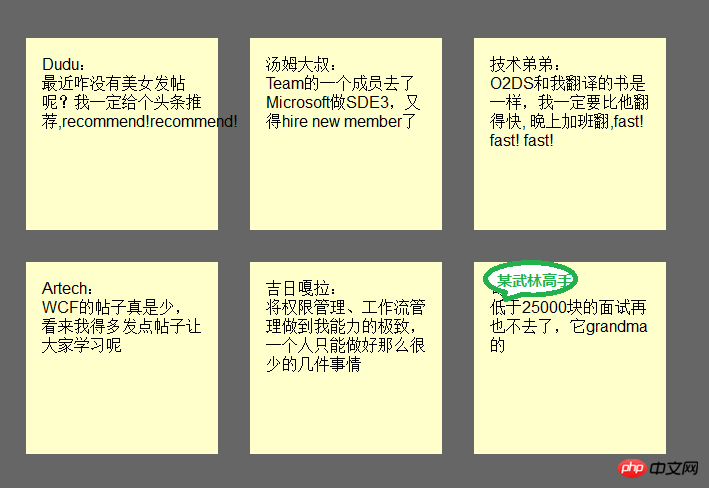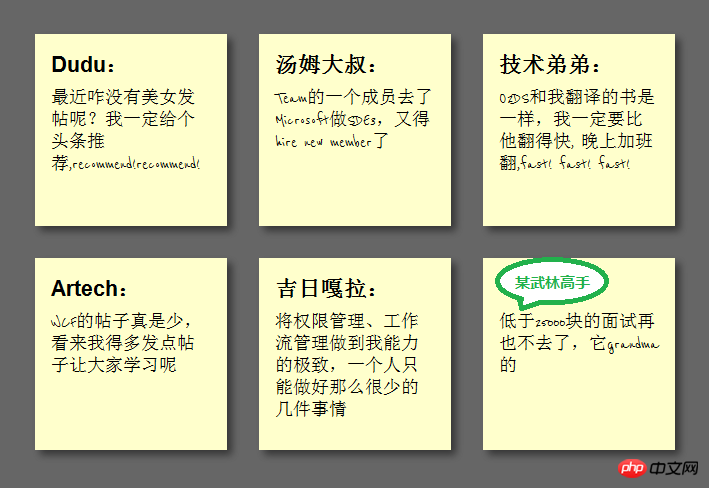 Web Front-end
Web Front-end
 H5 Tutorial
H5 Tutorial
 Use HTML5/CSS3 to quickly create special effects code examples for sticky notes in five steps (pictures and text)
Use HTML5/CSS3 to quickly create special effects code examples for sticky notes in five steps (pictures and text)
Use HTML5/CSS3 to quickly create special effects code examples for sticky notes in five steps (pictures and text)
Abstract
What this article will show you is how to use HTML5/CSS3 to create HTML with sticky note effect in just 5 steps Page, the renderings are as follows:
(Note: The text in the picture is purely fabricated, for humorous purposes, any similarity is purely coincidental, thank you! )

Note: This effect can be seen in Safari, Chrome, Firefox and Opera. The effect cannot be seen on IE due to incomplete support for HTML5.
Step 1: Create basic HTML and squares
First add the basic HTML structure and build the basic square. The code is as follows:
Dudu: 最近咋没有美女发帖呢?我一定给个头条推荐,recommend!recommend! 汤姆大叔: Team的一个成员去了Microsoft做SDE3,又得hire new member了 技术弟弟: O2DS和我翻译的书是一样,我一定要比他翻得快, 晚上加班翻,fast! fast! fast! Artech: WCF的帖子真是少,看来我得多发点帖子让大家学习呢 吉日嘎拉: 将权限管理、工作流管理做到我能力的极致,一个人只能做好那么很少的几件事情 某武林高手: 低于25000块的面试再也不去了,它grandma的
Add an href to each note Connection, mainly to support keyboard access, the CSS code is as follows:
{:;:;}{:;:;:;:;:;}{:;:;}{:;}{:;:;}{:;:;:;:;:;:;:;}{:;:;}The effect is as follows:

Step 2: Shadow and handwritten cursive characters
This step is to achieve the square shadow effect and change the font to cursive (English only), because Google provides support for Font API , so we can use it directly. First add the call to the Google API:
<link href="http://fonts.googleapis.com/css?family=Reenie+Beanie:regular" rel="stylesheet" type="text/css">
and then set the reference to this font:
{:;:;:;}{:;:;}Regarding the shadow, since each browser still has Neither of them are fully supported, so they need to be processed separately. The code is as follows:
{:;:;:;:;:;:;:; :; :; :;}The effect is as follows:

Step 3: Incline the square
In order to make the square tilt, we need to add the following code in li->a:
{:;:;:;}But in order to make the square tilt randomly instead of all tilting, we need to use a new CSS3 selector to make the square In every 2 tilts, 4 deg, every 3 tilts, negative 3 deg, and every 5 tilts, 5 deg:
{:;:;:;:;:;}{:;:;:;:;:;}{:;:;:;:;:;}The effect is as follows:

Step 4: Scale the square during Hover and Focus
To achieve the scaling effect during Hover and Focus, we need to add the following code:
{:;:;:;:;:;:;:;:;}Set z-index The value of 5 is to allow the square to cover other squares when zooming in. At the same time, because focus is also set, the Tab key is also supported for switching access. The effect is as follows:

Step 5: Smooth transition and add color
The special effects in the fourth step look a bit stiff. We can add Transition to achieve a smooth animation effect. In addition, the color is relatively single. We can set different colors. First add Transition in ul->li->a:
<span style="max-width:90%"> -moz-transition:-moz-transform .15s linear; <br/> -o-transition:-o-transform .15s linear; <br/> -webkit-transition:-webkit-transform .15s linear; </span>
and then define different colors in even and 3n:
{:;:;:;:;:;:;}{:;:;:;:;:;:;}In this way, This completes our final effect:

Summary
At this point, we have used the basic features of HTML5 and CSS3 to make a pretty good sticky note The effect is that HTML5/CSS3 is indeed very powerful. If you add some advanced features, such as combining it with JavaScript, you can achieve even more awesome effects. You can see this from the HTML5 Lab series of articles given by Dang Knight Brick. .
The above is the detailed content of Use HTML5/CSS3 to quickly create special effects code examples for sticky notes in five steps (pictures and text). For more information, please follow other related articles on the PHP Chinese website!

Hot AI Tools

Undress AI Tool
Undress images for free

Undresser.AI Undress
AI-powered app for creating realistic nude photos

AI Clothes Remover
Online AI tool for removing clothes from photos.

Clothoff.io
AI clothes remover

Video Face Swap
Swap faces in any video effortlessly with our completely free AI face swap tool!

Hot Article

Hot Tools

Notepad++7.3.1
Easy-to-use and free code editor

SublimeText3 Chinese version
Chinese version, very easy to use

Zend Studio 13.0.1
Powerful PHP integrated development environment

Dreamweaver CS6
Visual web development tools

SublimeText3 Mac version
God-level code editing software (SublimeText3)
 How to use radio buttons in HTML5?
Jul 21, 2025 am 01:08 AM
How to use radio buttons in HTML5?
Jul 21, 2025 am 01:08 AM
The key to using radio buttons in HTML5 is to understand how they work and correctly organize the code structure. 1. The name attribute of each radio button must be the same to achieve mutually exclusive selection; 2. Use label tags to improve accessibility and click experience; 3. It is recommended to wrap each option in a div or label to enhance structural clarity and style control; 4. Set default selections through the checked attribute; 5. The value value should be concise and meaningful, which is convenient for form submission processing; 6. The style can be customized through CSS, but the function needs to be ensured to be normal. Mastering these key points can effectively avoid common problems and improve the effectiveness of use.
 Differentiating HTML5 localStorage and sessionStorage
Jul 15, 2025 am 03:12 AM
Differentiating HTML5 localStorage and sessionStorage
Jul 15, 2025 am 03:12 AM
The core difference between localStorage and sessionStorage lies in data persistence and scope. 1. Data life cycle: localStorage data is stored for a long time unless manually cleared, and sessionStorage data is cleared after closing the tab; 2. Scope difference: localStorage is shared among all tabs on the same website, and sessionStorage is stored independently; 3. Usage scenario: localStorage is suitable for saving long-term data such as user preferences and login status, sessionStorage is suitable for temporary form data or single session process; 4. API consistency: two operation methods
 Is the tag still used in HTML5?
Jul 21, 2025 am 02:47 AM
Is the tag still used in HTML5?
Jul 21, 2025 am 02:47 AM
Yes, it is part of HTML5, but its use has gradually decreased and is controversial. Used to combine the main title with the subtitle so that only the highest level of titles are identified in the document outline; for example, the main title and subtitle can be wrapped in to indicate that they are only auxiliary titles rather than independent chapter titles; however, reasons why they are no longer widely used include: 1. The browser and screen readers are inconsistent support for them, 2. There are simpler alternatives such as using CSS to control styles, 3. The HTML document outline algorithm is not widely supported; despite this, it can still be considered in websites or documents with high semantic requirements; while in most cases, developers tend to use a single, manage styles through CSS and maintain clear title levels.
 How to write a basic HTML5 page template?
Jul 26, 2025 am 07:23 AM
How to write a basic HTML5 page template?
Jul 26, 2025 am 07:23 AM
Declare the document as HTML5 to avoid the browser from entering weird mode; 2. Define the root element and specify the language to improve accessibility and SEO; 3. It includes ensuring correct character encoding, implementing responsive design, and setting page title; 4. Place all visible content, optionally add CSS, favicon and JavaScript links; this template is complete and compatible with modern browsers, and is suitable for any new HTML file.
 Understanding Server-Sent Events in HTML5
Jul 23, 2025 am 01:21 AM
Understanding Server-Sent Events in HTML5
Jul 23, 2025 am 01:21 AM
Server-SentEvents (SSE) is a technology in HTML5 that implements server pushing data to clients in real time, and is suitable for stock market, notification systems and other scenarios. It is based on the HTTP protocol, and remains open after establishing a connection. The server can send updates at any time, supporting automatic reconnection and standard data formats. The front-end receives data by creating an EventSource object and listening to message events. The backend needs to set the correct MIME type (text/event-stream) and keep the connection open and continuously output data stream. When using it, you need to pay attention to cross-domain issues, connection timeouts, browser compatibility and intermediate layer restrictions.
 Defining custom vocabularies using HTML5 Schema.org markup.
Jul 31, 2025 am 10:50 AM
Defining custom vocabularies using HTML5 Schema.org markup.
Jul 31, 2025 am 10:50 AM
The Schema.org tag helps search engines understand the structured data format of web page content through semantic tags (such as item scope, item type, itemprop); it can be used to define custom vocabulary, methods include extending existing types or using additionalType to introduce new types; in actual applications, keeping the structure clear, using official attributes first, testing code validity, and ensuring that custom types are accessible; precautions include accepting partial support, avoiding spelling errors, and choosing a suitable format such as JSON-LD.
 When to use the HTML5 `` tag?
Jul 15, 2025 am 03:17 AM
When to use the HTML5 `` tag?
Jul 15, 2025 am 03:17 AM
HTML5 tags are used to wrap the main content of a web page. The content should be unique to the page and not included in other page shared parts such as header, footer or navigation menus. It belongs to the semantic element, which helps browsers and assistive technologies understand website structure. 1. It should contain content that directly associates the core purpose of the page, such as article text, page-specific forms, interactive widgets bound to the current page, and media files that are the focus of the page; 2. Use can improve accessibility and SEO, including better screen reader support, clearer DOM structure and enhanced SEO through semantic clarity; 3. It should not be used in components such as footer, sidebar or pop-ups, nor should it be used for content that is repeated across pages, and can only be used once per page; 4. If the page does not have it
 How does the HTML5 parser handle errors?
Aug 02, 2025 am 07:51 AM
How does the HTML5 parser handle errors?
Aug 02, 2025 am 07:51 AM
HTML5parsershandlemalformedHTMLbyfollowingadeterministicalgorithmtoensureconsistentandrobustrendering.1.Formismatchedorunclosedtags,theparserautomaticallyclosestagsandadjustsnestingbasedoncontext,suchasclosingabeforeaandreopeningitafterward.2.Withimp






